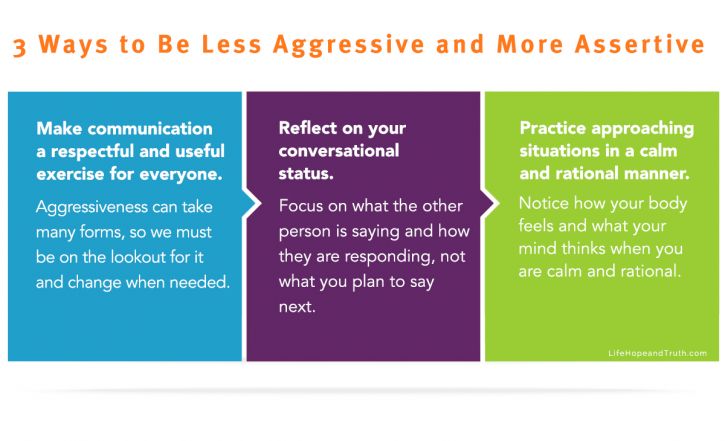Communication Styles: Aggressive Communication
The third communication style is one of anger and seeking superiority. How damaging is aggressive communication? Why should we strive to be assertive instead?
An aggressive communicator often lords it over another person in a conversation by using insulting and belittling statements.
Aggressive communication is usually the easiest communication style to spot, but also the hardest to overcome. Acknowledging personality traits is a vital part of transforming an aggressive style to a more assertive style.
What is aggressive communication?
The easiest (but perhaps too simplistic) way to define aggressive communication is to call it the opposite of passive communication. Aggressive communication does not display an inner feeling of powerlessness or helplessness, and it almost always expresses emotions and thoughts. The problem with this style lies in how those emotions and thoughts are expressed.
An aggressive communicator is usually not interested in having an actual conversation. It is a communication style used to lord it over another person in a conversation (Luke 22:24-26) and often includes insulting and belittling statements about others (Matthew 5:22).
Aggressive communicators attack others, dominate conversations and set themselves up as the alpha male (or female) of the communication. Interrupting frequently and rarely listening very well, aggressive communicators usually have their own set of talking points that they will get across no matter what.
This makes for terrible conversation. It usually becomes one-sided, with nearly all give and no take.
Though aggressive communicators don’t use these exact words, here are the messages they often give off in conversation:
- “How stupid are you to believe that? I can’t believe you are so naïve and gullible.”
- “What you said or did was wrong, and you need to think of the reasons why and tell me. I’ll tell you if you get the right answers.”
- “I am the expert on this topic, so I’m the only person who has a valid opinion on this.”
- “What you are saying isn’t important or interesting to me, so I’m going to say what I want.”
- “I am the life of this conversation and will bring everything being said back to me.”
- “I’ve made my decision about this before even speaking to you. So here is what’s what.”
What do we notice? Aggressive communication displays power-hungry exertions of authority, pride and overconfidence. This style rejects open-ended questions and allows only the “right” answers according to the “expert.”
Are there any benefits of aggressive communication?
Aggressive communication, like passive communication, has illusory benefits. Others might think we are in a leadership or authority position, listen to us with more attention than they would otherwise, or enjoy our confidence. But that will only be temporary, because instead of drawing people closer, aggressive communication nearly always repels others from us.
Instead of leading people, the aggressive communicator will trample over and push people down—often leaving a trail of hurt and mistrust.
Instead of leading people, the aggressive communicator will trample over and push people down—often leaving a trail of hurt and mistrust. The thinking behind aggressive communication is usually not compatible with the fruit of the Holy Spirit, but it is rather more akin to the works of the flesh (such as outbursts of wrath) found in Galatians 5.
Even the instances in which Christ appeared to be aggressive in His communication (for example, driving out the money changers from the temple or chastising the Pharisees) were not attempts to prove authority, win arguments or degrade others. They were assertive attempts to influence other people to stop sinning in their communication and conduct!
It is interesting that in so many instances Christ’s assertive communication was geared toward treating people in the right way and honoring God, while the aggression of those He chastised led them to want Christ dead and to call Him all sorts of names.
To learn more about this, read our article “Religious Zeal: The Bad and the Good.”
What are the consequences of aggressive communication?
It is easy to notice aggressive communicators, because they don’t try to hide that they are aggressive. Part of the nature of aggressive communication, and its biggest consequence, is that it doesn’t care or even realize how off-putting and obnoxious it comes across to for so many on the receiving end.
This does not make these people want to be around us, much less communicate with us on a regular basis.

How can I be less aggressive and more assertive?
- Make communication a respectful and useful exercise for everyone. Aggressive communication is really only functional for the person being aggressive. Aggressiveness can take many forms, so we must be on the lookout for it and change when needed.
- The lecturer. With self-imposed authority, we shame all the naysayers and lecture others on why our way is the only way. We assume everyone else only has questions, and we are the sole possessor of all answers. If we find ourselves becoming the lecturer, we can remember that different perspectives can provide nuance and deeper understanding, if we stop lecturing for a minute to listen.
- The attack dog. With venom and insults, the hound goes after the prey. If our attack dog jumps off the leash, we can remember that hatred and outbursts of wrath are nowhere near the fruit of the Spirit. This style may seem to help, but it definitely is not needed. Calm and assertive communication is always more effective than attacks.
- The storyteller. With a long-winded and an “I love to hear myself talk” style, we completely command and dominate a conversation. If we find ourselves becoming the storyteller, we can try to recognize and read faces to determine if our communication partners are getting bored. The seemingly harmless storyteller, believe it or not, can often be very aggressive, taking sole command of a conversation, perhaps without realizing it.
- Reflect on our conversational status often during conversation. There are many helpful questions to ask ourselves in the midst of conversation to avoid being so aggressive:
- “Have I asked this person any questions about himself or herself?”
- “After others answer, do I immediately talk about myself again?”
- “Have I insulted this person or invalidated his or her feelings in this conversation?”
- “Does this person seem to be enjoying and benefitting from this conversation, or is he or she looking bored and perturbed?”
- “Have I conceded (or agreed with) any logical and valid points made by the other person?”
- “Have I complimented the other person at all?”
- “Am I showing love in this conversation?”
- Practice approaching situations in a calm and rational manner often, not just during communication. Using a calm and rational approach in other areas of our lives can help us do the same in our communication.
If we are talking nonstop, we can make a conscious effort to stop, slow down and listen (Proverbs 1:5). We should notice how our body feels and what our mind thinks when we are calm and rational versus when we feel we must get our point across at all costs.
Some scriptures to help us overcome aggressive communication
- “And just as you want men to do to you, you also do to them likewise” (Luke 6:31).
- “A soft answer turns away wrath, but a harsh word stirs up anger” (Proverbs 15:1).
- “Let your speech always be with grace, seasoned with salt, that you may know how you ought to answer each one” (Colossians 4:6).
- “So then, my beloved brethren, let every man be swift to hear, slow to speak, slow to wrath” (James 1:19).
Though it may sometimes appear to be the communication style of a leader, aggressive communication falls short of assertive communication because it is more a hallmark of a dictator or elitist than of a true selfless leader.
Aggressive communication can be genuine—genuinely lacking in humility, love, gentleness and tact. Assertive communication has all the benefits and gets the message across without hurting or walking all over others.
Part 1: Assertive Communication
Part 2: Passive Communication
Part 4: Passive-Aggressive Communication
For more insights on communication, read our articles on “The Joys and Challenges of Communication.”
Date Posted: February 10, 2020

 by Eddie and Shannon Foster
by Eddie and Shannon Foster

